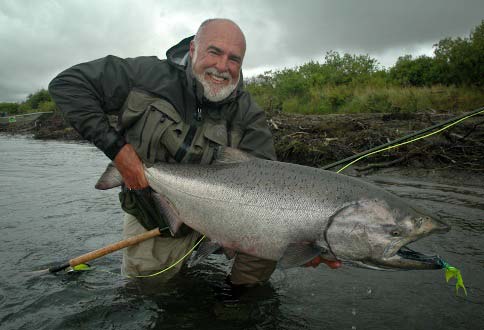
Today’s casting tip comes from Jeff Hickman, professional guide, signature tier for Idylwilde Flies and owner of Fish the Swing LLC. Jeff guided many years at Alaska West for Deneki Outdoors and spent most of that time teaching anglers how to effectively cast and fish the two-handed rod, one of the more efficient ways to catch our state’s fall steelhead or critters like the massive king pictured above.
For some reason, people equate Spey rods to long casts. Sure, you can cast great distances with your two-handed rod, but that is not the main advantage of using one. In fact, much of the time anglers actually end up casting too far, making the Spey’s ability to toss line a disadvantage!
The real advantages for Alaska anglers—fall and spring trout, steelhead and king hunters in particular—are that your fly stays in the water longer, meaning you’re fishing more; you can control your swing much better with the longer rod, and you can cast using much less effort and with limited room behind you.
Some spots do require a long cast to fish effectively, but not many. In most situations the fish lay out of the heavy current not far from the shoreline. Plus, even with most sink-tips attached, when you cast way out into the fast water, the fly doesn’t sink at all. The heavy tension on the line can also wreck the speed of the swing, ruining your chances before the fly even enters the softer holding water where the fish are more likely to be. More importantly, when you cast long the fly doesn’t swing effectively all the way in below you, so you aren’t even fishing the whole spot! (A lot of hits come on the drop-down, making it an essential piece of fishing any water structure.)
Finally, never underestimate the water right in front of you that can only be covered with a really short cast. It may seem less heroic, but the grab with only a few feet of line out is savage!
